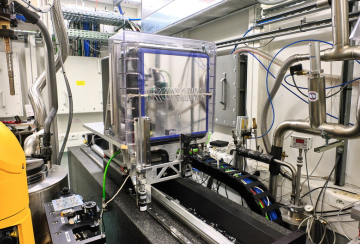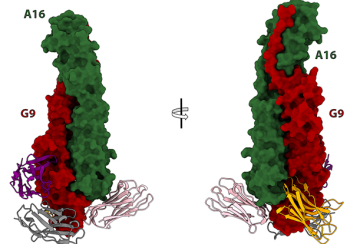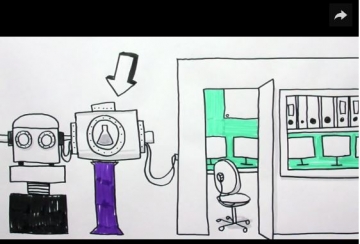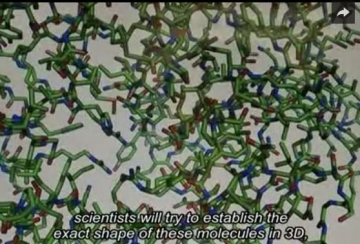
PROXIMA-1
Structural study of biological macromolecules using crystallography
PROXIMA-1 operates within the biology and health scientific section (HelioBiology) of SOLEIL to complement the integrated structural biology approach made available at SOLEIL. Operational since March 2008, PROXIMA-1 delivers an intense, nearly parallel and tunable x-ray beam for measurements at high resolution or from large unit cell dimension crystals. As such, it is one of the two beamlines for macromolecular crystallography, together with PROXIMA-2A. Equipped with a very large surface area detector and coupled to a fast sample exchange robot, the instrument allows for a high throughput of numerous protein crystals in record time. Advanced data collection strategies are routinely set when taking advantage of the latest generation three-circle Chi geometry goniostat, opening the experiments for complex experimental phasing.
Team

Our latest postings on Twitter
Technical data
between 6.5 et 15.0 keV
2E-4 (Si 111)
U20 In-vacuum undulator
- Be-lenses transfocator
- channel cut cryogenically cooled monochromator
- Kirkpatrick-Baez pair of bi-morph mirrors
- 3-cercles Chi-geometry goniometer (SoC : 1 µm on Chi)
- CATS-type sample changer
- Oxford Cryosystems cryostream
- Si drift diode energy dispersive detector plus MCA for fluorescence measurements
classically 40 x 20 µm2
approximately 2.0 E+12 phot/s/0.02%bw for a ring current of 500 mA
EIGER-X 16M (Dectris Ltd.)
Linear
Scientific opportunities
| High resolution macromolecular crystallography |
High resolution diffraction measurements (< 0.8 Å). |
|---|---|
| Large unit cell MX |
Diffraction measurements from crystals with large unit cell dimensions (complexes, viruses). |
| Phasing by MAD and SAD |
|
| Applied Research |
|
In terms of in house research at SOLEIL, the PROXIMA-1 beamline team belongs to the following scientific section:
| Scientific section at SOLEIL | Biology and health, HelioBiology |
|---|
Beamline references
PROXIMA-1
When using the beamline, please cite the following publication :
Coati, A., Chavas, L.M.G., Fontaine, P. et al. Status of the crystallography beamlines at synchrotron SOLEIL . Eur. Phys. J. Plus 132, 174 (2017). https://doi.org/10.1140/epjp/i2017-11403-3
MXCuBE
When referring to MXCuBE, please cite the following publication :
Oscarsson, M., Beteva, A., Flot, D. et al. MXCuBE2: the dawn of MXCuBE Collaboration . J. Synchrotron Rad. 26, 393-405 (2019). https://doi.org/10.1107/S1600577519001267
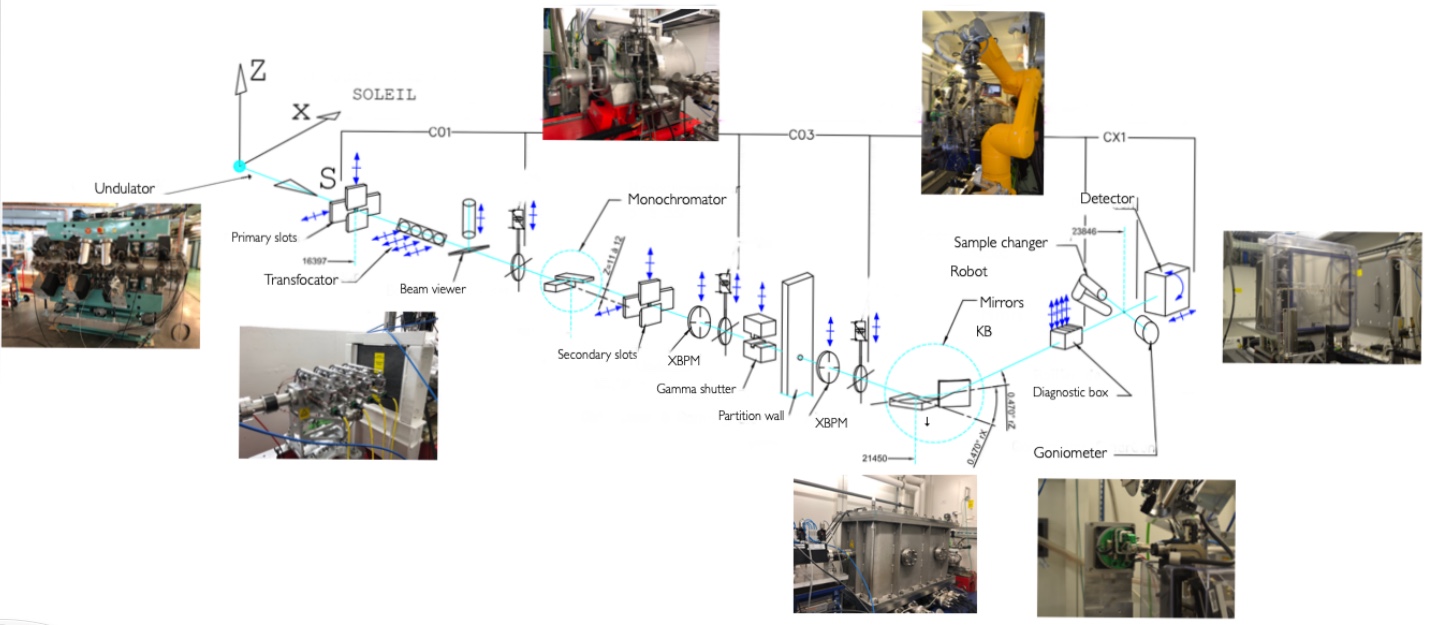
Undulator
The source of the light line is an in vacuum U20 undulator, containing 100 periods of 20 mm. 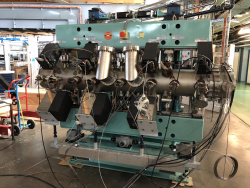
This undulator type was chosen in order to cover a large energy spectrum with nearly no loss in brilliance.
Transfocator
A transfocator can be defined as an optical equipment consisting in positioning lenses in the beam to modify its geometrical properties. In our case, to overcome the chromatic aberration of Beryllium, this equipment must have motors to insert or remove the lenses and a vacuum proof enclosure. The lenses are positioned in copper stacks that differ in the number of lenses they have. Thus the first stack (closest to the source) has 4 lenses and corresponds to the focusing configuration for 6 keV. The stack number 2 has 5 lenses and allows covering an energy of 7 keV. The stack number 3 has 6 lenses for an energy of 8 keV. Finally, stack number 4 contains 7 lenses for an energy of 9keV. Through different combinations of stacks it becomes thus possible to cover a large energy range until all the stacks are inserted for 15 keV.
Monochromator
A monochromator is a device used in optics to select a narrow range of energies from a beam of wider energy range. 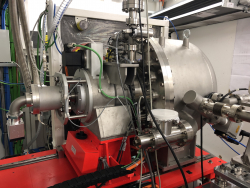
The PROXIMA-1 beamline is equipped with a channel cut monochromator made from a Si(111) crystal, which allows for selecting an energy range running from 6 keV to 15 keV with a very fast speed for changing the energy.
Bimorph K/B mirrors
Bimorph Kirkpatrick-Baez mirrors, or KB mirrors for short, focuses beams of x-rays by reflecting them at grazing incidence off a curved surface, usually coated with a layer of a heavy metal. 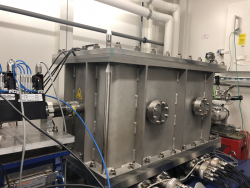
KB mirrors can focus beams to small spot sizes with minimal loss of intensity. They typically are used in pairs - one to focus horizontally and one for vertical focusing. When the horizontal and vertical focuses coincide, the x-ray beam is focused to the so-called focal point, generally the sample to be analysed.
Goniometer
The goniometer was created by the company SmarAct. It allows the proper centring of the sample to the x-ray focal point. At PROXIMA-1, the goniometer is composed of 3 main rotation axes. 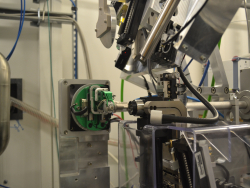
The Omega axis is the main rotation axis. To allow for full data collection, it can rotate over 360°. The sphere of confusion (SoC) for the Omega is typically below the micron.
The second rotation axis is the Chi axis, less flexible, with a rotation range from 0º to 50º. The SdC for the Chi reaches 2 microns or less.
The Phi axis is the third rotation axis, located at the very end of the Chi axis. In image to the Omega axis, Phi is also able to rotate by over 360º. The SdC for Phi reaches 2-3 microns.
Sample exchange robot
The sample exchange robot is manufactured by Staubli, with an option for microfluidic chip handling. 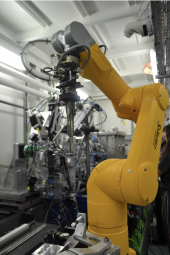
The robot picks up samples stored within storage cassettes belonging to the UniPUCK design, which can store 16 samples per cassette. The robot storage Dewar can handle 3 UniPUCKS, corresponding to 48 samples overall.
Detector
The PROXIMA-1 beamline is equipped with an Eiger-X 16M detector (Dectris Ltd.), optimised for data collection speeds of 100 Hz. 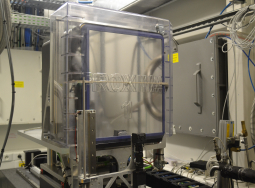
The detector will typically provide with a master file containing all the experimental parameters (image_name_master.h5) and raw data images contained in diffraction image files (image_name_data_#####.h5).
Before the experiment
Login and password retrieval from the SunSET
PROXIMA-1 NoMachine connection
Equipment available on the beamline
- Ketek SDD detector for measuring XANES spectra ;
- Oxford Cryosystemes Cryostream 700 series for sample cooling ;
- Various Dewars for handling and transfer of samples ;
- Tools and UniPUCKs for preparation of robot samples ;
- EigerX 16M detector with a standard data collection rate of 100 Hz ;
- Sample exchange robot CATS, with optional microfluidic chip handling.
/!\ Length of loops
The cryoloops that can be used on the beamlines are of the standard SPINE format. For more information, please visit the following website : https://instrumentation.embl.fr/spinesampleholder/pdf/DM_16100_-_Sample_holder.pdf .
The efficient combination of the sample exchange robot with the goniometer relies on a very sensitive interaction between both. As a direct consequence, the sample use on the beamline cannot vary too much from the SPINE standard. However, acceptable lengths could reach +- 2 mm when compared to the standard lengths specified in the SPINE format.
Data backup and online retrieval (GLOBUS)
Data backup at Synchrotron SOLEIL is performed the ‘old way’, physically on hard drives which should be provided by the user. Sftp or related transfer systems are not supported at SOLEIL, neither for data import or data export out of SOLEIL. The data backup is performed through USB-based external hard drives that could be mounted on beamline LINUX computers. PROXIMA-1 could eventually lend hard drives to users in urgent needs, for short periods of time. Some backup software for quick data transfer onto the hard drives are available on the beamline.
Online data backup is possible using GLOBUS : https://www.globus.org. Read and download instructions : Globus Manual
For users willing to use the sample exchange robot
In order to get familiar with the various techniques employed on the beamline, a series of videos are available to watch, highlighting the following :
- How to prepare liquid nitrogen : video
- How to transfer samples stored in vials into Unipucks : video
- How to load Unipucks inside the robot Dewar : video
- How to get samples from Unipucks back to vials : video
Local contacts and experiments starting times
Synchrotron SOLEIL typically allocates three 8-hours shifts for performing experiments, starting from 8AM and until 8AM on the following day. In order to be more flexible in terms of beamline use, both MX teams have agreed upon flexible planifications in consultation with the users.
The project principal investigators are usually contacted some 5 weeks prior to the scheduled experimental Run. By following a shared scheduling calendar, the PIs then have the choice to select either 1 shift (8AM - 4PM), 2 shifts (4PM - 8AM), or the classical 3 shifts. The final shift scheduling is performed by discussion among the PI, the beamline responsible, and the local contact assigned for the shift(s).
To simplify the experiments, and to permit obtaining a more stable x-ray beam, the users are asked to accept a delay of maximum 30 minutes before taking over the beamline (e.g. starting at 8:30 instead of 8:00). During these 30 minutes, the local contact will take time to properly align the x-ray beam, prepare the beamline for the start of the experiments, and explain users how the shift(s) will be organised and how to adequately use the beamline.
The local contact will be available until 17:30 for any particular explanation on the beamline use. After, users are asked to share information among them to avoid losing precious beam time when shifting groups. Between 17:30 and 23:00, the local contact will be reachable by phone for any advice or remote action that would help users on demand. In case problems happen between 23:00 and 08:00 on the next morning, users have to follow SOLEIL’s procedure and phone the hall coordinator (phone number : 97 97, 24/7). If the problem cannot be solved, experiments will be stopped until further notice. The local contact can only be called during the night shifts when the experiments put the user or the hardware of the instrument at risk.
Dewar handling
Dewars should be sent via your prefered shipper to :
Synchrotron SOLEIL - PROXIMA-1
L'Orme des Merisiers
Départementale 128
91190 Saint AUBIN France
It is recommended that you notify your local contact of the shipping. The Dewars will be filled on arrival. Return shipping must be pre-paid.
Access and BIOLABs equipments
FAQ
A FAQ list is made available on the beamline, with detailed work-around procedures. When the FAQ does not allow the users to fix the problems and resume their experiments, please do contact the beamline responsible who will be making all the possible efforts to fix the problem at his/her earliest convenience.
User manual
Beamline control with MXCuBE
The MXCuBE software allows users to control the beamline components and provides automated methods to perform MX experiments. The MXCuBE manual can be downloaded from the following link.
The video shows how to operate MXCuBE, mount a crystal on the goniometer using the robot, center a crystal, characterize and collect the crystal. It also shows how to perform X-ray centring if the crystal is not clearly visible in the loop, and how to perform helical data collection.
Performing an energy scan in MXCuBE
Data visualisation with ADXV
To show resolution rings, in Adxv Control window, click on Edit, Properties, Resolution Rings : ON
Data visualisation with ALBULA
Launch albula_3.2
In EIGER monitor, check if IP address is 195.221.8.71 port 80 Pause 2
Data analysis
The data analysis scripts from the xdsme suite, developed and maintained by Pierre Legrand, have been integrated at the beamline for a semi-automated data analysis. Scripts can be downloaded, together with instructions on how to use those, at the following ![]() link.
link.
Useful manuals available for download
The following files are available for download, for off-line readings before the scheduled experiments in order to better appreciate the experiments to come.
 remote access manual (704.05 KB) : for better understanding the procedures to apply to remotely connect to PROXIMA-1. The manual is self-consistent and needs to be strictly followed in order to experience smooth and painless connection.
remote access manual (704.05 KB) : for better understanding the procedures to apply to remotely connect to PROXIMA-1. The manual is self-consistent and needs to be strictly followed in order to experience smooth and painless connection. proxima1 user manual (1.5 MB) : quick reminders of functions most often used within MXCuBE, together with some workaround hints when falling in frequently encountered issues while using the beamline.
proxima1 user manual (1.5 MB) : quick reminders of functions most often used within MXCuBE, together with some workaround hints when falling in frequently encountered issues while using the beamline.
Beamline projects
AcceS-Ge CoViD-19 - Accelerated structural genomics on proteins coding for the pathogen responsible for the CoViD-19, using our in vivo macromolecular crystallography pipeline.
Internal collaboration
HelioBiology
This scientific section was created in 2006 with all the scientists involved in biological sciences at SOLEIL. Being strongly interdisciplinary and at the junction where scientific measurement and project meet, the HelioBiology group focuses on the development of innovative methods in order to help advance the most difficult “external user” research. This is of critical importance in the highly competitive and labour intensive field of the biological sciences: by allowing the study of the widest range of samples, these methodological improvements can make the difference between success and failure, or publishing the first or second. Several very important publications have resulted from this symbiosis between beamline scientist and user at SOLEIL.
External collaboration
More to come…

